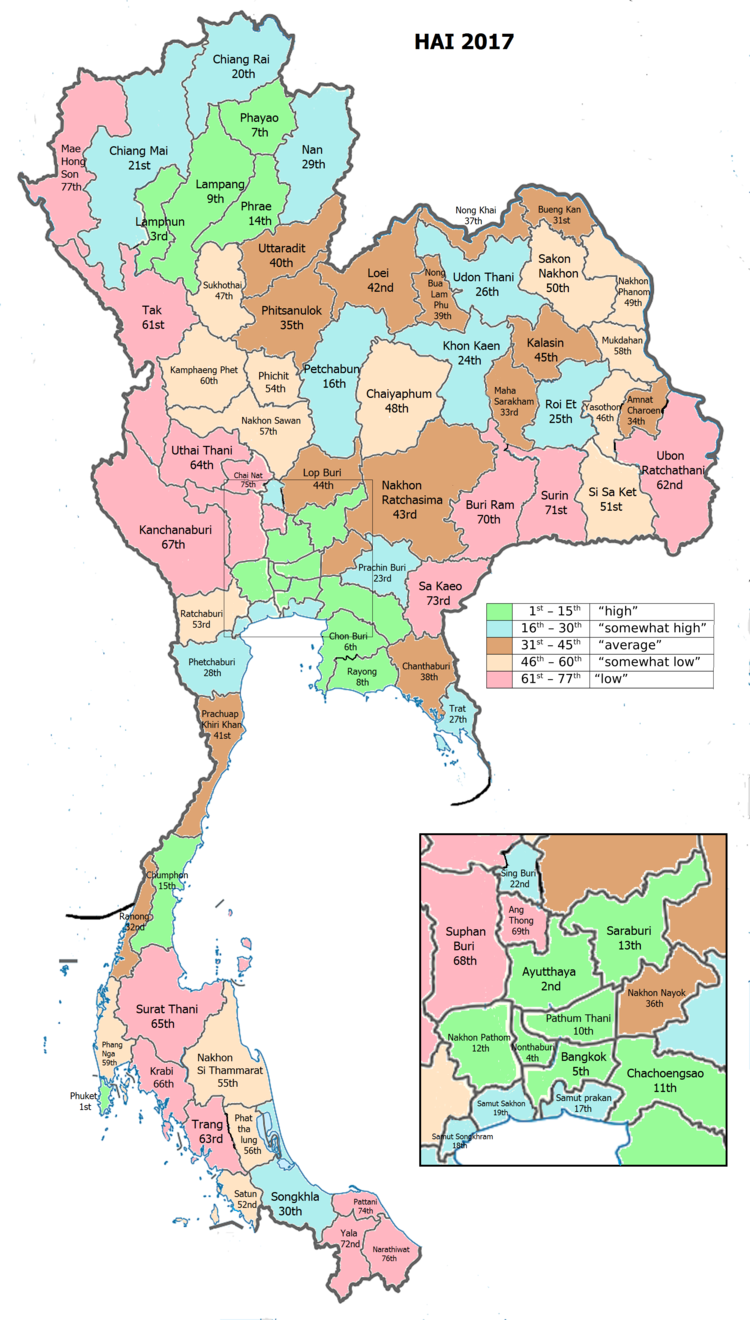Kalasin Province
Kalasin
กาฬสินธุ์ | |
|---|---|
 | |
 Flag  Seal | |
| Nickname(s): Green Heart of Thailand Mueang Nam Dam (black water city) | |
| Motto(s): "หลวงพ่อองค์ดำลือเลือง เมืองฟ้าแดดสงยาง โปงลางเลิศล้ำ วัฒนธรรมภูไท ผ้าไหมแพรวา ผาเสวยภูพาน มหาธารลำปาว ไดโนเสาร์สัตว์โลกล้านปี" ("Reverend Father Ong Dam, Fahdang Song Yang City, Ponglang Exception, Phu Thai culture, Praewa Silk, Pha Savoey Phu Phan, Maha Tarn Lampao and Dinosaur, animal world, million years") | |
 Map of Thailand highlighting Kalasin Province | |
| Coordinates: 16°25′57″N 103°30′25″E / 16.43250°N 103.50694°ECoordinates: 16°25′57″N 103°30′25″E / 16.43250°N 103.50694°E | |
| Country | Thailand |
| Capital | Kalasin town |
| Government | |
| • Governor | Songpol Jai-krim (since October 2020)[1] |
| Area | |
| • Total | 6,936 km2 (2,678 sq mi) |
| Area rank | Ranked 27th |
| Population (2019)[3] | |
| • Total | 983,418 |
| • Rank | Ranked 23rd |
| • Density | 142/km2 (370/sq mi) |
| • Density rank | Ranked 29th |
| Human Achievement Index | |
| • HAI (2017) | 0.5793 "average" Ranked 45th |
| Time zone | UTC+7 (ICT) |
| Postal code | 46xxx |
| Calling code | 043 |
| ISO 3166 code | TH-46 |
| Vehicle registration | กาฬสินธุ์ |
| Website | www |

Kalasin (Thai: กาฬสินธุ์, pronounced [kāːlāsǐn]) is one of Thailand's seventy-six provinces (changwat) lies in upper northeastern Thailand also called Isan. The province was established by the Act Establishing Changwat Kalasin, BE 2490 (1947), and it came into existence on 1 October 1947. Neighboring provinces are (from north clockwise) Sakon Nakhon, Mukdahan, Roi Et, Maha Sarakham, Khon Kaen, and Udon Thani.
Geography[]
Most of the province is covered by hilly landscape. The town of Kalasin is at an elevation of 152 m (499 ft).[5] In the north is the Lam Pao Dam built from 1963 to 1968. It stores 1,430 million m3 of water for flood prevention and agriculture. The Lam Pao reservoir effectively cuts the northern part of the province in half, but there are car ferries connecting the district of Sahatsakhan in the east with the district Nong Kung Si in the west, saving up to one hour off the journey by road. On the northwestern creek of the reservoir, a road bridge connects the village of Ban Dong Bang in the west with the district town of Wang Sam Mo in the east. Although the bridge was constructed several years ago (pre-2000), it is not featured (2006) on any commercially available road maps.
The Phu Phan mountain range marks the border with Sakhon Nakhon Province, part of which is preserved as a national park. The total forest area is 759 km2 (293 sq mi) or 10.9 percent of provincial area.[2]
Kalasin is known for the dinosaur fossils found at Phu Kum Khao (Sahatsakhan District), the largest dinosaur site in Thailand. Most of the fossils are sauropods from 120 million years ago.
Economy[]
Kalasin is an agricultural province producing sticky rice and other cash crops such as manioc (cassava) and sugar cane. Families are generally poor in this essentially rural area and make ends meet by producing baskets and the silk for which the region is renowned.[citation needed]
History[]
Archaeological excavations show that the Lawa tribe lived in the area some 1,600 years ago. The first official town was founded in 1793.
During the Thesaphiban reforms in the reign of King Rama V at the beginning of the 20th century, the town (mueang) was upgraded to a province. In 1932, when the country experienced the great economic depression, the province was demoted and absorbed as a district by Maha Sarakham Province to reduce the financial burden on the country,[6] Kalasin was dependent on Maha Sarakham for 16 years. After the great recession and World War II, it once again became a province in 1947.[7]
Symbols[]
The seal of the province shows a pond in front of the Phu Phan Mountains which form the boundary of the province. The water in the pond is black, as the name Kalasin means "black water". The big clouds as well as the water symbolize the fertility of the province.
The provincial logo and landmark is the Phra That Yakhu, an octagonal-shaped chedi, made of bricks.
The provincial flower is payorm or sweet shorea (Shorea roxburghii), and the provincial tree is sa-mae-san ().
The provincial slogan is Fa Daet Song Yang ancient city, Pong Lang folk music, Phu Thai culture, Phrae Wa silk, Pha Saweoi Phu Phan, Lam Pao River, and million-year dinosaurs.
Administrative divisions[]
Provincial government[]

The province is divided into 18 districts (amphoes). The districts are further divided into 134 subdistricts (tambons) and 1,509 villages (mubans).
Local government[]
As of 26 November 2019 there are:[8] one Kalasin Provincial Administration Organisation (ongkan borihan suan changwat) and 79 municipal (thesaban) areas in the province. Kalasin and Bua Khao have town (thesaban mueang) status. Further 77 subdistrict municipalities (thesaban tambon). The non-municipal areas are administered by 71 Subdistrict Administrative Organisations - SAO (ongkan borihan suan tambon).[3]
Human achievement index 2017[]
| Health | Education | Employment | Income |
| 31 | 59 | 19 | 72 |
| Housing | Family | Transport | Participation |

|
 |

|
|
| 10 | 20 | 69 | 23 |
| Province Kalasin, with an HAI 2017 value of 0.5793 is "average", occupies place 45 in the ranking. | |||
Since 2003, United Nations Development Programme (UNDP) in Thailand has tracked progress on human development at sub-national level using the (HAI), a composite index covering all the eight key areas of human development. National Economic and Social Development Board (NESDB) has taken over this task since 2017.[4]
| Rank | Classification |
| 1 - 15 | "high" |
| 16 - 30 | "somewhat high" |
| 31 - 45 | "average" |
| 45 - 60 | "somewhat low" |
| 61 - 77 | "low" |
| showMap with provinces and HAI 2017 rankings |
References[]
- ^ "ประกาศสำนักนายกรัฐมนตรี เรื่อง แต่งตั้งข้าราชการพลเรือนสามัญ" [Announcement of the Prime Minister's Office regarding the appointment of civil servants] (PDF). Royal Thai Government Gazette. 137 (Special 194 Ngor). 8. 24 August 2020. Retrieved 13 April 2021.
- ^ Jump up to: a b "ตารางที่ 2 พี้นที่ป่าไม้ แยกรายจังหวัด พ.ศ.2562" [Table 2 Forest area Separate province year 2019]. Royal Forest Department (in Thai). 2019. Retrieved 6 April 2021, information, Forest statistics Year 2019, Thailand boundary from Department of Provincial Administration in 2013CS1 maint: postscript (link)
- ^ Jump up to: a b รายงานสถิติจำนวนประชากรและบ้านประจำปี พ.ส.2562 [Statistics, population and house statistics for the year 2019]. Registration Office Department of the Interior, Ministry of the Interior. stat.bora.dopa.go.th (in Thai). 31 December 2019. Retrieved 26 February 2020.
- ^ Jump up to: a b Human achievement index 2017 by National Economic and Social Development Board (NESDB), pages 1-40, maps 1-9, retrieved 14 September 2019, ISBN 978-974-9769-33-1
- ^ "Elevation of Kalasin,Thailand Elevation Map, Topo, Contour". FloodMap. Retrieved 26 December 2017.
- ^ พระบรมราชโองการ ประกาศ ยุบรวมท้องที่บางมณฑลและบางจังหวัด (PDF). Royal Gazette (in Thai). 48 (ก): 576–578. 1932-02-21.
- ^ พระราชบัญญัติจัดตั้งจังหวัดกาฬสินธุ์ พ.ศ. ๒๔๙๐ (PDF). Royal Gazette (in Thai). 64 (36 ก): 516–517. 1947-08-12.
- ^ "Number of local government organizations by province". dla.go.th. Department of Local Administration (DLA). 26 November 2019. Retrieved 10 December 2019.
3 Kalasin: 1 PAO, 2 Town mun., 77 Subdistrict mun., 71 SAO.
External links[]
 Kalasin travel guide from Wikivoyage
Kalasin travel guide from Wikivoyage- Provincial website (Thai)
- Kalasin, Tourist Authority of Thailand
- Kalasin Province
- Isan
- Provinces of Thailand

